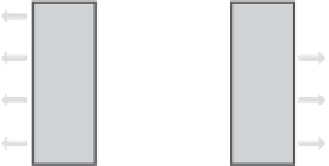Information Technology Reference
In-Depth Information
Use cabinets with mesh fronts and backs.
■
Custom perforated tiles with larger openings.
■
Key
To p i c
Rack
Rack
Rack
Rack
Figure 4-5
Data Center Cold and Hot Aisles
Note:
1 watt = 3.41214 British thermal units (BTU). Many manufacturers publish kW,
kilovolt ampere (kWA), and BTU in their equipment specifications. Sometimes dividing the
BTU value by 3.413 does not equal the published wattage. Use the manufacturer informa-
tion if available, if not this can be a helpful conversion formula to use.
Data Center Heat
Blade server deployments allow for more efficient use of space for servers, which is good,
but there is also an increased amount of heat per server, which requires more cooling to
maintain consistent temperatures.
The data center design must address the increased use of high density servers and the heat
that they produce. During the data center design, considerations for cooling need to be
taken into account for the proper sizing of the servers and the anticipated growth of the
servers along with their corresponding heat output.
Here are some cooling solutions to address the increasing heat production:
Increase the number of HVAC units.
■
Increase the airflow through the devices.
■
Increase the space between the racks and rows.
■
Use alternative cooling technologies, such as water-cooled racks.
■
Data Center Cabling
The cabling in the data center is known as the passive infrastructure. Data center teams
rely on a structured and well-organized cabling plant. Although the active electronics are
crucial for keeping server, storage, and network devices up and running, the physical ca-
bling infrastructure is what ties everything together. The cabling in the data center termi-
nates connections between devices and governs how each device communicates with one
another.
Cabling has several key characteristics, such as the physical connector, media type, and
cable length. Copper and fiber-optic cables are commonly used today.
bling allows for longer distances and is less prone to interference than copper



















